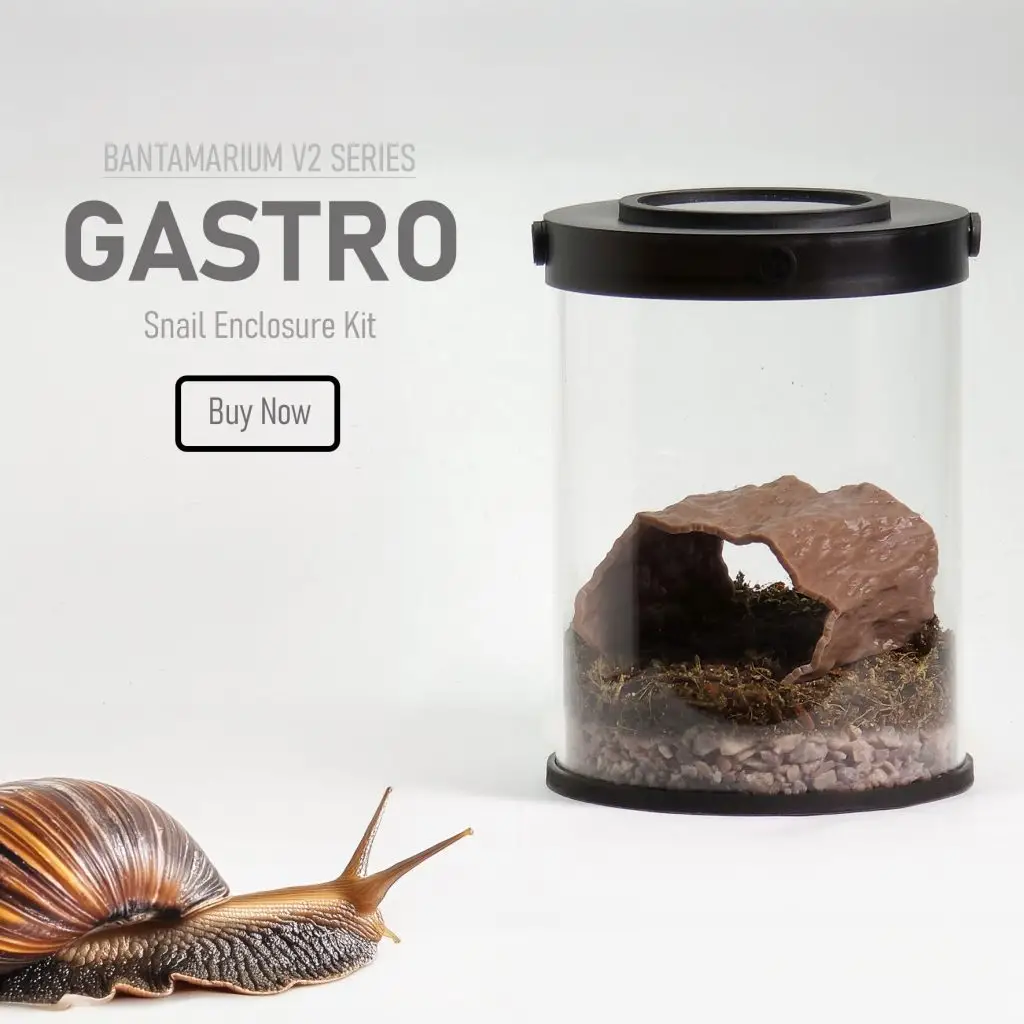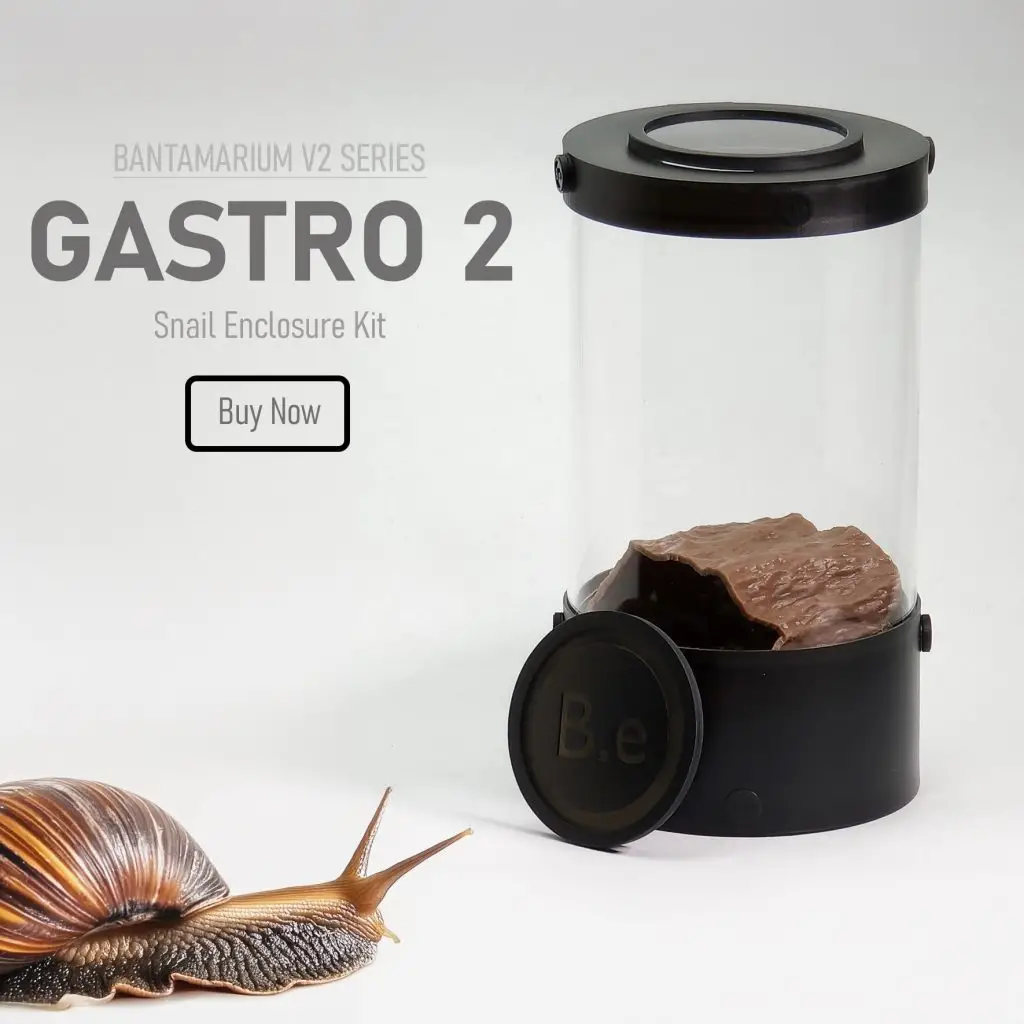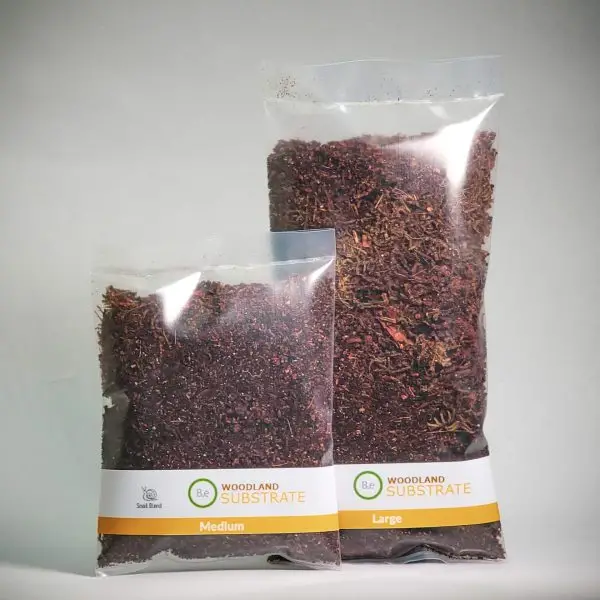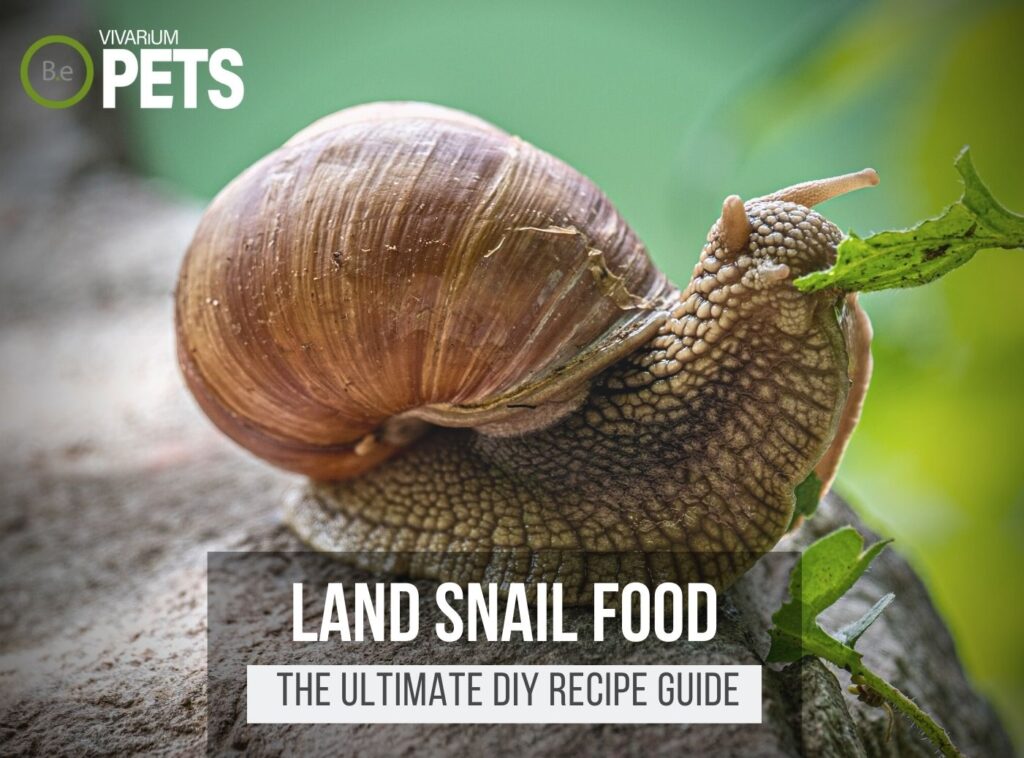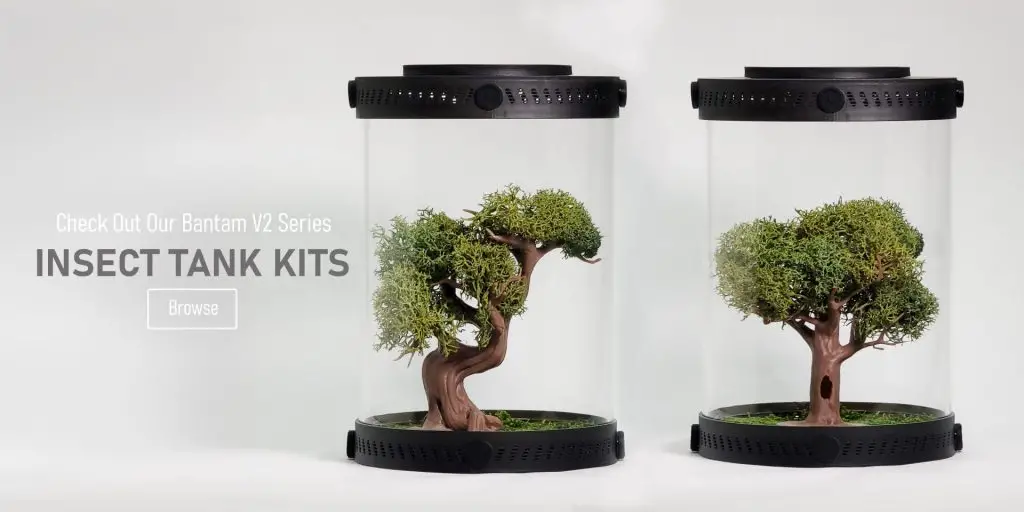Whenever the sun goes down and the garden is alight with the soft glow of fireflies, you may be lucky enough to spot one of the brightest residents in your backyard—the green garden snail (Cantareus apertus).
With its distinct silhouette, this vibrant species is a wonder to behold!
Learn all about this fascinating terrarium snail, from its habitat and distribution to its appearance, by exploring this informative article.
Come on a journey to discover the importance of green garden snails (and why they are worth having in a terrarium).
Table Of Contents:
ToggleWhat Are Green Garden Snails?
Green garden snails, also known as Cantareus apertus, belong to the family Helicidae.
These small white and light brown to dark green mollusks typically grow up to be a few centimeters long and sport attractive and varied spiral patterns on their shells.
The common name Green Garden Snail comes from their fondness of damp, woodland environments and their habit of feeding on leaves and vegetation and is a reflection of their presence in gardens and other green spaces.
Create an ideal habitat for your pet snails with our Customizable Snail Enclosure Kits, which include everything you need to get started.
What Do Green Garden Snails Look Like?
Green Garden Snails usually measure 1-2 centimeters in length and typically have a brown and white or gray and yellow striped pattern.
They possess two large main tentacles and two smaller tentacles on their heads.
The main tentacles can be retractable and help the Green Garden Snail navigate their habitat.
The shells of Cantareus apertus are easily identifiable with ridges or “whorls” that spiral around the body.
The underside of the shell is often white and smooth.
Their tiny foot pads are used for locomotion and are important for maintaining moisture for the snail to stay alive.
Benefits Of Using Green Garden Snails
Green garden snails are becoming increasingly popular among vivarium owners because they represent a natural way to keep the environment clean and free of debris.
In the wild, snails graze freely on the ground, consuming leftover vegetation and other organic matter.
When placed in vivariums, they help to break down plant matter, such as fallen leaves and overripe fruit, keeping the environment healthy and stable by creating a natural food cycle.
Additionally, snails are easy to care for and require minimal maintenance, making them ideal for those who are looking for a low-maintenance pet.
Finally, Cantareus apertus can bring a sense of peace and calmness to the miniature environment, making it a pleasant place to spend time.


Green Garden Snail Facts
Green Garden Snails, or Cantareus apertus, are small, land-based snails that feed primarily on leaves, roots, and decaying matter.
These herbivores are slow-moving and get along well with other species, attracting beneficial predators to the area.
They can live up to five years and breed from late spring to early fall. With effective protection, they can be a welcome addition to any indoor or outdoor garden.
Habitat
Green garden snails are believed to have originated in southern Europe and are now considered native to many other areas.
The species was most likely spread by humans over the past few centuries.
Cantareus apertus prefers a moist environment and can be found in gardens, parks, and forests.
They are most active on rainy and cloudy days. The snails prefer to stay in shady spots where they can find plenty of food and where the soil is not too dry.
Their ideal habitat includes moist areas filled with shrubs, grasses, mosses, and small plants.
Our Bioactive Land Snail Substrate Blend is specially formulated to meet the needs of various land snail species, providing an optimal balance of moisture and nutrients.
Diet
Green Garden Snails are herbivores that feed mainly on leafy vegetation.
In their natural habitat, they scavenge for succulent plants like moss and algae, as well as medium and low vegetation like grasses and smaller plants.
They have also been known to enjoy the occasional piece of fruit, such as apples and pears, that have fallen to the ground.
As they feed, they help to keep the local ecosystem balanced by supporting the growth of plants and controlling the overpopulation of certain species.
Cantareus apertus also consumes calcium deposits from rocks, soil, and other low-lying surfaces to develop a thick protective layer around their soft bodies.
This process is called “shell formation” and helps to protect the delicate snail from predators and environmental damage.
In turn, the snail’s presence also helps to limit the number of pests in the local garden, as the snail’s diet dislodges small insects and other invertebrates that are harmful to plant life.
Temperament
Green garden snails have an incredibly peaceful temperament and are non-aggressive around humans and larger animals.
While the snails may not show obvious signs of affection, they are very friendly and tend to hide their presence from potential threats.
Green garden snails show receptiveness to each other, which is known as ‘sociality’.
They are known to feed off each other’s shells and sometimes even groom each other.
They are also known to exhibit behaviors such as sleeping close to each other and snuggling up to one another.
Cantareus apertus are also not known to attack or compete with other animals.
As herbivores, they normally eat the leaves and flowers of plants, leaving them with plenty of food to go around.
They are known to stay away from other animals and mind their own business, which makes them well-liked by their neighbors!
Lifespan
The lifespan of Cantareus apertus can vary greatly depending on precise conditions.
Generally speaking, green garden snails tend to live between 2–3 years, although their lifespan can extend to up to many more years in appropriate environments.
The life cycle of a green garden snail is made up of three stages: egg, juvenile, and adult.
During the egg stage, snails hatch from their eggs in the soil and remain until their larvae appendages are fully developed.
Once their larvae are fully grown, the snails will start to mature and finally reach adulthood.
Breeding
Green Garden Snails reproduce sexually, meaning two different snails must participate in the mating process.
The two snails will engage in a courtship display which involves them circling each other and touching their heads and tentacles.
After successful mating, the female snail will lay between 40 and 50 eggs at a time.
Depending on the surrounding environment, the eggs can take up to 4 months to hatch.
The young snails will not have a sexually developed adult body right away and must pass through a couple of larval stages to reach the mature, adult form.
The Green Garden Snail is also capable of quickly repopulating an area if the conditions are favorable for them to do so.
Once an area is fully populated by the snails, they can quickly and easily spread to adjacent areas and quickly reproduce.
This is why it’s important to maintain an optimal environment for the snail if you want to prevent an overpopulation of the species in your backyard.
Where To Find Green Garden Snails
Finding green garden snails in the wild is a fairly simple process.
They prefer to live in moist habitats with plenty of vegetation, like garden beds, flower beds, and along stream or pond banks, so these are great places to start your search.
Green garden snails are nocturnal, so it’s best to search for them at night or in the early hours of the morning when they’re most active.
You may also find green garden snails for sale at plant nurseries, pet stores, and certain specialty retailers.
When you look for Cantareus apertus for sale, it’s important to make sure that the specimens you’re getting are healthy and properly cared for.
It’s best to stick to retailers who specialize in snails and possess the knowledge to answer all of your questions before you bring a new snail home.
Additionally, if you find green garden snails wild, it’s best to leave them in their natural habitat.
They are an important part of their ecosystem and should be respected.
Green Garden Snail Care
Caring for Cantareus apertus requires providing them with the right environment, which should be humid and moist, and with the right food, which should include different types of leaves.
Additionally, it can be helpful to install predator deterrents, like impenetrable barriers, and provide the snails with safe hiding spots to protect them from attacks by predators.
Tank Requirements
Green Garden Snails thrive best in humid, semi-aquatic habitats that mimic the wet, muddy conditions they naturally search for in the wild.
The ideal vivarium type is a 10-gallon tank with the top essentially covered by a lid or mosquito netting.
The pH level should range between 6.5 and 8.5, with an optimal hardness measured in GH (7 to 8) and KH (3 to 6).
The temperature should stay between 75 and 80 degrees Fahrenheit and can be regulated by heat pads and/or under-tank heaters as needed.
As for terrarium substrate, a mixture of moisture-retaining soil, gravel, sand, and terrarium plants, both living and artificial can provide the safe and comfortable environment that the snail needs.
Lastly, the terrarium lighting should be no more than 12 hours of low-wattage LED bulbs, as direct sunlight can be too intense and damaging for inexperienced snails.
What Do Green Garden Snails Eat?
Feeding your Green Garden Snails is an essential part of caring for them properly.
As herbivores, Cantareus apertus will graze on a variety of vegetation, including fruits and vegetables, leafy greens, and soft flowers.
Here is a list of specific food items to feed your Green Garden Snails:
- Dark Kale Leaves
- Dandelion Leaves
- Lettuce Leaves
- Carrot Tops
- Spinach Leaves
- Collard Greens
- Apple Slices (preferably organic)
- Grapes
- Orange Slices
- Watermelon Slices
- Strawberries (cut in half)
- Cucumbers (sliced)
- Bananas (sliced)
It is important to only feed your snails the above items in moderation.
To maintain a healthy diet, it is best to provide them with a variety of vegetables and fruits.
Additionally, clean out any uneaten food for up to 72 hours to avoid mold, bacteria, and fungus buildup.
If you’re more of an avid hobbyist like myself, be sure to check out my ultimate DIY land snail food guide. I give a more in-depth explanation of the best foods and my favorite recipe.
Best Tankmates For Green Garden Snails
Green Garden Snails are not known to be very social animals and aren’t likely to form friendships with any of the other inhabitants of their tank.
So it is not necessary to have tankmates to keep them happy and healthy.
Nevertheless, there are a few other animals that have similar beneficial qualities that can be considered safe tankmates for Cantareus apertus.
These tankmates should not be too large or too predatory and should enjoy similar conditions in terms of temperature, pH, and water hardness.
The most suitable tankmates for Green Garden Snails include algae eaters such as Malaysian Trumpet Snails, Mystery Snails, and White Garden Snails.
These creatures will help keep your tank clean and can complement the behavior, diet, and lifestyle of C. apertus.
But you should always monitor their interactions to ensure that they’re getting along, and be ready to separate them if necessary.
Conclusion
The green garden snail is a surprisingly fascinating creature that plays an important role in the ecosystem and is worth protecting.
As animal keepers, it’s important to become familiar with the pet snails and how to properly care for them to help maintain a healthy population.
With a little bit of knowledge about Cantareus apertus and effort, we can create a buzzing green oasis and reap the rewards of a diverse and flourishing ecosystem.
Create the ideal habitat for your snails with our species-specific soil mixes and Insect Enclosure Kits. These products provide everything you need for a successful and thriving snail habitat.

